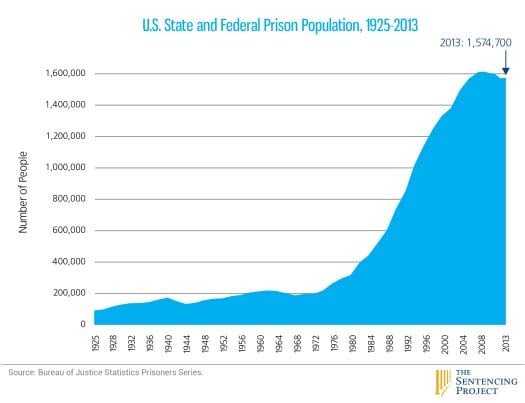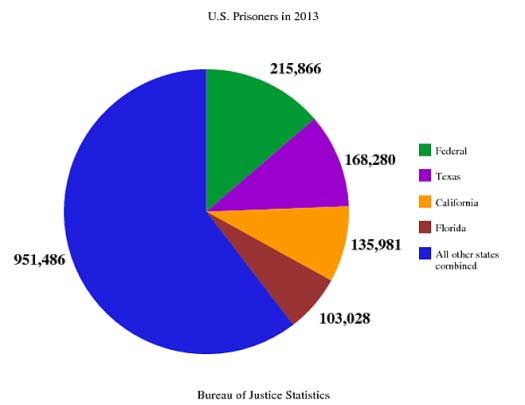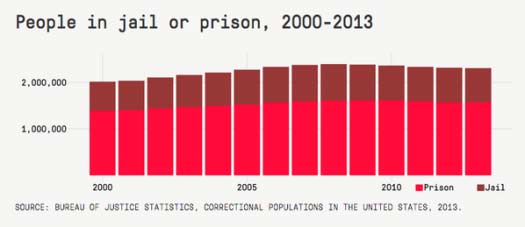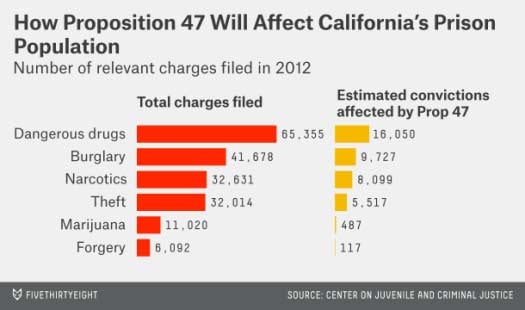
Last year, I offered a year-end list of key developments in the PIC. People seemed to appreciate the recap so I produced a 2014 version. As was true last year, there are many developments that didn’t make the list including the report by the National Research Council that analyzed the exponential growth of US incarceration, the announcement that New York City will end punitive solitary confinement for juveniles, the continued criminalization of motherhood (especially black mothers), the ongoing criminalization of LGBTQ people, multiple botched executions, the indictment of Christopher Epps, Mississippi’s corrections commissioner for corruption, and more.
We are STILL in the era of “mass” & “hyper” incarceration.
1. In 2014, we learned that state prison populations actually increased last year. In 2013, the prison population was 1,574,741, an increase of about 4,300 over the previous year, but below its high of 1,615,487 in 2009. This was the first increase in state prison population in four years. Read the full report here (PDF).
 Source: The Sentencing Project (2014)
Source: The Sentencing Project (2014)
The prison population in New Hampshire grew faster than any other state. The state’s 8.2% increase topped second-place Nebraska’s 6.8% rise and far outstripped the 0.3% national increase in the number of prisoners. Below is a pie chart that breaks down the proportion of prisoners in state & federal facilities.
 Source: Texas Observer, 9/17/14
Source: Texas Observer, 9/17/14
2. The prison AND jail population in the US declined slightly in 2013.
The decrease can be mostly attributed to a decline in the number of people in jail. The number of people in local jails last year fell by almost 2 percent – to 731,200. The US is still the world’s largest jailer by a mile.
 Source: The Marshall Project
Source: The Marshall Project
Police violence continues unabated… and to does the resistance.
3. This year will be remembered for the deaths of Tanisha Anderson, Mike Brown, Eric Garner, Tamir Rice, and more.
It will also be remembered for the sustained resistance to police violence catalyzed by protests in Ferguson, Missouri.
4. A group of 8 young people of color from Chicago took their charge of genocide to the United Nations Committee Against Torture to internationalize the struggle against police violence.
This was the year that the school-to-prison pipeline went mainstream as a concept.
5. The Federal government acknowledged the existence of a school to prison pipeline and for the first time ever offered official guidance to school districts for how to address it.
Data from the 2011-2012 Civil Rights Data Collection show that Black students make up 44 percent of students suspended more than once and 36 percent of students expelled, though they represent only 16 percent of students. In addition, Black students represent 27 percent of students referred by schools to law enforcement, and 31 percent of students arrested for an offense committed in school. The Federal guidance is intended to address racial discrimination in school discipline policy.
It’s hard to believe that we needed to pass legislation banning sterilization of prisoners in 2014 but we did.
6. On September 25, Governor Jerry Brown signed SB 1135, an anti-sterilization bill championed by Justice NOW. Justice NOW provided some background about illegal sterilizations in California prisons:
“The discovery that upwards of 100 illegal sterilizations of pregnant people imprisoned at Valley State Prison for Women and California Institution for Women between 2006-2010 spurred lawmakers into action. A report by the Center for Investigative Reporting released last year revealed that at least 250 such sterilizations may have occurred since the late 1990s; a story based on years of research, documentation and advocacy by Justice Now in collaboration with people in California women’s prisons. A state audit released in May of this year confirmed that the tubal ligations performed between 2006-2010 in some cases were done illegally not meeting legal requirements for informed consent and that prison is such a coercive environment that the ability to give consent could not be established therefor tubal ligations should not be performed.”
Everyone says that they want to end the so-called war on drugs. This year, the DOJ and Congress gave a few nods in the direction of sentencing reform.
7. The US Sentencing Commission voted to retroactively apply an amendment they approved earlier this year that lowers federal guidelines for sentencing persons convicted of drug trafficking offenses. As Anthony Papa explains:
“The underlying drug guidelines amendment was approved by the US Sentencing Commission and submitted to Congress for review in April. Provided Congress takes no action to disapprove of the drug guidelines amendment before November 1, 2014, it will take effect on that date and courts may then begin considering petitions from incarcerated individuals for sentence reductions. Today’s vote allows the drug guidelines amendment to apply retroactively. The US Sentencing Commission ruled that no one who benefits from this reform may be released from prison before November 1, 2015.”
More information can be found here (PDF).
Unfortunately, in 2014, there was still no justice for women who defend themselves from violence.
8. Marissa Alexander accepted a plea deal. By pleading guilty to three felony charges, Marissa was ordered to serve three years in jail. With time served, she is set to be released on January 27 when she will have another hearing to determine whether she will have to serve more prison time as part of an open plea. She will have to serve two years under house arrest for sure.
Read the statement by the Free Marissa NOW mobilization campaign for more information.
In 2014, we continued to torture incarcerated children.
9. The Federal government (Department of Justice) announces that it will sue over the terrible conditions for adolescent detainees at Rikers Island Jail.
Specifically, the Complaint alleges:
- Staff use force against Young Inmates with alarming frequency. In Fiscal Year 2014, there were 553 reported staff use of force incidents involving Young Inmates at the Robert D. Davoren Center (“RNDC”) and the Eric M. Taylor Center (“EMTC”), the two facilities that housed most Young Inmates. These incidents resulted in 1,088 injuries.
- Inmate-on-inmate fights and assaults are pervasive in large part because inmates are inadequately supervised by inexperienced and poorly trained officers. In Fiscal Year 2014, there were 657 reported inmate-on-inmate fights involving Young Inmates at RNDC and EMTC.
- Staff use of force and inmate-on-inmate fights and assaults have resulted in an alarming number of serious injuries to Young Inmates, including broken jaws, broken orbital bones, broken noses, long bone fractures, and lacerations requiring stitches.
- Staff frequently punch, strike, or kick Young Inmates in the head or facial area.
- Force is used as a means to punish Young Inmates, and staff unnecessarily continue to use force against inmates who already have been restrained.
- Force is used in response to inmate verbal taunts and insults.
- Specialized response teams, including probe and cell extraction teams, use excessive force.
- Staff regularly tell inmates to “stop resisting,” even though the inmate has been completely subdued, to justify the use of force.
- Use of excessive force is common in areas outside video surveillance coverage. DOC recently transferred many 18-year-old inmates to housing units that have no video surveillance at all.
In some states, local activists used the ballot box as a tool for decarceration.
10. Proposition 47 “The Safe Neighborhoods and Schools Act” passed in California. The proposition reclassifies drug and theft crimes that involve less than $950 from felonies to misdemeanors. Below are some estimates of how the proposition might impact incarceration in California. More details on potential effects are here.
 Source: Five Thirty Eight
Source: Five Thirty Eight
In 2014, the Prison Industrial Complex was STILL racist.
11. People of color are even more overrepresented in private prisons than in public ones. According to Harrison Jacobs:
“While minorities are disproportionately incarcerated in all prisons in America — The Sentencing Project, a reform advocacy group, puts the number for racial and ethnic minorities as high as 60% of those imprisoned — the percentage of minorities in private prisons is often higher than 60% in some states’ private prisons and reaches 89% in California’s private prisons, according to the study recently published in the Journal of Radical Criminology by UC Berkeley doctoral candidate Christopher Petrella.
Said Petrella: “I came to find out that through explicitly and implicitly exemptions written into contracts between these private prison management companies and state departments of correction, many of these privates … write exemptions for certain types of prisoners into their contracts … And, as you can guess, the prisoners they like to house are low-cost prisoners … Those prisoners tend to be younger, and they tend to be much healthier.”
Based on historical sentencing patterns, says Petrella, prisoners over 50 years old are predominantly white. Those prisoners who are in the 20-40 year-old range are far more likely to be black, Hispanic, or any other minority.
The difference in prison demographics stems from The War on Drugs, which has been criticized as targeting minority communities and imposing draconian mandatory minimum sentences.”
Old myths were debunked but maintain their power to oppress.
12. Twenty years later, the so-called superpredator wave is debunked as myth.
“In 1995, John DiIulio, a professor at Princeton who coined the term “superpredator,” predicted that the number of juveniles in custody would increase three-fold in the coming years and that, by 2010, there would be “an estimated 270,000 more young predators on the streets than in 1990.” Criminologist James Fox joined in the rhetoric, saying publicly, “Unless we act today, we’re going to have a bloodbath when these kids grow up.”
These predictions set off a panic, fueled by highly publicized heinous crimes committed by juvenile offenders, which led nearly every state to pass legislation between 1992 and 1999 that dramatically increased the treatment of juveniles as adults for purposes of sentencing and punishment.
As Dilulio and Fox themselves later admitted, the prediction of a juvenile superpredator epidemic turned out to be wrong. In fact, violent juvenile crime rates had already started to fall in the mid-1990’s. By 2000, the juvenile homicide rate stabilized below the 1985 level.”
We continue to torture people with impunity.
13. The long-awaited CIA torture report was released and it was as horrific as feared. From the New York Times:
“The report describes extensive waterboarding as a “series of near drownings” and suggests that more prisoners were subjected to waterboarding than the three prisoners the C.I.A. has acknowledged in the past. The report also describes detainees being subjected to sleep deprivation for up to a week, medically unnecessary “rectal feeding” and death threats. Conditions at one prison, described by a clandestine officer as a “dungeon,” were blamed for the death of a detainee, and the harsh techniques were described as leading to “psychological and behavioral issues, including hallucinations, paranoia, insomnia, and attempts at self-harm and self-mutilation.”
The full 500 page executive summary of the report can be downloaded here(PDF).
We’re not backing down in the face of Trump’s threats.
As Donald Trump is inaugurated a second time, independent media organizations are faced with urgent mandates: Tell the truth more loudly than ever before. Do that work even as our standard modes of distribution (such as social media platforms) are being manipulated and curtailed by forces of fascist repression and ruthless capitalism. Do that work even as journalism and journalists face targeted attacks, including from the government itself. And do that work in community, never forgetting that we’re not shouting into a faceless void – we’re reaching out to real people amid a life-threatening political climate.
Our task is formidable, and it requires us to ground ourselves in our principles, remind ourselves of our utility, dig in and commit.
As a dizzying number of corporate news organizations – either through need or greed – rush to implement new ways to further monetize their content, and others acquiesce to Trump’s wishes, now is a time for movement media-makers to double down on community-first models.
At Truthout, we are reaffirming our commitments on this front: We won’t run ads or have a paywall because we believe that everyone should have access to information, and that access should exist without barriers and free of distractions from craven corporate interests. We recognize the implications for democracy when information-seekers click a link only to find the article trapped behind a paywall or buried on a page with dozens of invasive ads. The laws of capitalism dictate an unending increase in monetization, and much of the media simply follows those laws. Truthout and many of our peers are dedicating ourselves to following other paths – a commitment which feels vital in a moment when corporations are evermore overtly embedded in government.
Over 80 percent of Truthout‘s funding comes from small individual donations from our community of readers, and the remaining 20 percent comes from a handful of social justice-oriented foundations. Over a third of our total budget is supported by recurring monthly donors, many of whom give because they want to help us keep Truthout barrier-free for everyone.
You can help by giving today. Whether you can make a small monthly donation or a larger gift, Truthout only works with your support.